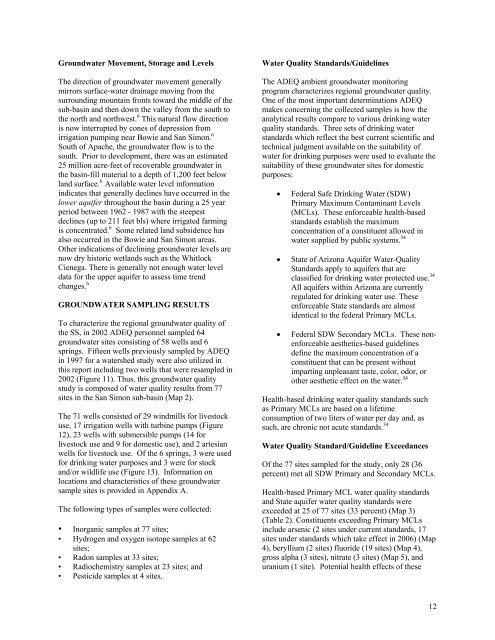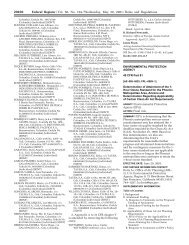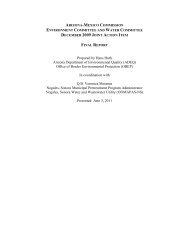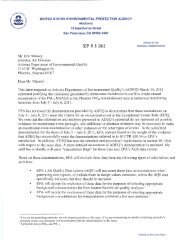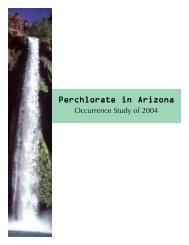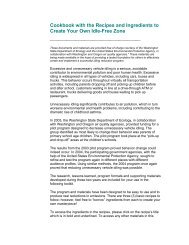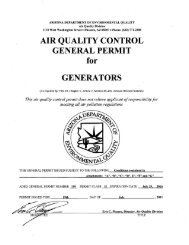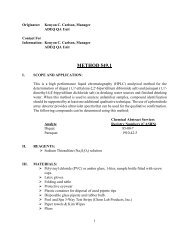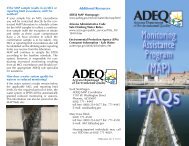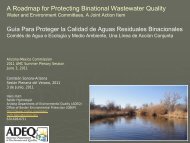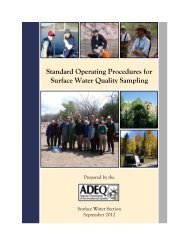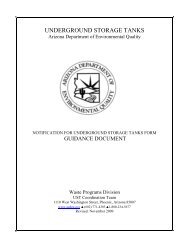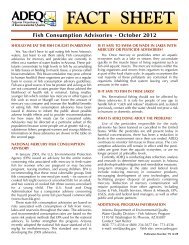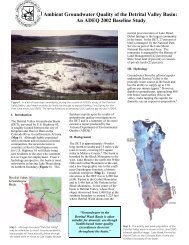San Simon Sub-Basin - Arizona Department of Environmental Quality
San Simon Sub-Basin - Arizona Department of Environmental Quality
San Simon Sub-Basin - Arizona Department of Environmental Quality
You also want an ePaper? Increase the reach of your titles
YUMPU automatically turns print PDFs into web optimized ePapers that Google loves.
Groundwater Movement, Storage and Levels<br />
The direction <strong>of</strong> groundwater movement generally<br />
mirrors surface-water drainage moving from the<br />
surrounding mountain fronts toward the middle <strong>of</strong> the<br />
sub-basin and then down the valley from the south to<br />
the north and northwest. 6 This natural flow direction<br />
is now interrupted by cones <strong>of</strong> depression from<br />
irrigation pumping near Bowie and <strong>San</strong> <strong>Simon</strong>. 6<br />
South <strong>of</strong> Apache, the groundwater flow is to the<br />
south. Prior to development, there was an estimated<br />
25 million acre-feet <strong>of</strong> recoverable groundwater in<br />
the basin-fill material to a depth <strong>of</strong> 1,200 feet below<br />
land surface. 6 Available water level information<br />
indicates that generally declines have occurred in the<br />
lower aquifer throughout the basin during a 25 year<br />
period between 1962 - 1987 with the steepest<br />
declines (up to 211 feet bls) where irrigated farming<br />
is concentrated. 6 Some related land subsidence has<br />
also occurred in the Bowie and <strong>San</strong> <strong>Simon</strong> areas.<br />
Other indications <strong>of</strong> declining groundwater levels are<br />
now dry historic wetlands such as the Whitlock<br />
Cienega. There is generally not enough water level<br />
data for the upper aquifer to assess time trend<br />
changes. 6<br />
GROUNDWATER SAMPLING RESULTS<br />
To characterize the regional groundwater quality <strong>of</strong><br />
the SS, in 2002 ADEQ personnel sampled 64<br />
groundwater sites consisting <strong>of</strong> 58 wells and 6<br />
springs. Fifteen wells previously sampled by ADEQ<br />
in 1997 for a watershed study were also utilized in<br />
this report including two wells that were resampled in<br />
2002 (Figure 11). Thus, this groundwater quality<br />
study is composed <strong>of</strong> water quality results from 77<br />
sites in the <strong>San</strong> <strong>Simon</strong> sub-basin (Map 2).<br />
The 71 wells consisted <strong>of</strong> 29 windmills for livestock<br />
use, 17 irrigation wells with turbine pumps (Figure<br />
12), 23 wells with submersible pumps (14 for<br />
livestock use and 9 for domestic use), and 2 artesian<br />
wells for livestock use. Of the 6 springs, 3 were used<br />
for drinking water purposes and 3 were for stock<br />
and/or wildlife use (Figure 13). Information on<br />
locations and characteristics <strong>of</strong> these groundwater<br />
sample sites is provided in Appendix A.<br />
The following types <strong>of</strong> samples were collected:<br />
• Inorganic samples at 77 sites;<br />
• Hydrogen and oxygen isotope samples at 62<br />
sites;<br />
• Radon samples at 33 sites;<br />
• Radiochemistry samples at 23 sites; and<br />
• Pesticide samples at 4 sites.<br />
Water <strong>Quality</strong> Standards/Guidelines<br />
The ADEQ ambient groundwater monitoring<br />
program characterizes regional groundwater quality.<br />
One <strong>of</strong> the most important determinations ADEQ<br />
makes concerning the collected samples is how the<br />
analytical results compare to various drinking water<br />
quality standards. Three sets <strong>of</strong> drinking water<br />
standards which reflect the best current scientific and<br />
technical judgment available on the suitability <strong>of</strong><br />
water for drinking purposes were used to evaluate the<br />
suitability <strong>of</strong> these groundwater sites for domestic<br />
purposes:<br />
• Federal Safe Drinking Water (SDW)<br />
Primary Maximum Contaminant Levels<br />
(MCLs). These enforceable health-based<br />
standards establish the maximum<br />
concentration <strong>of</strong> a constituent allowed in<br />
water supplied by public systems. 34<br />
• State <strong>of</strong> <strong>Arizona</strong> Aquifer Water-<strong>Quality</strong><br />
Standards apply to aquifers that are<br />
classified for drinking water protected use. 34<br />
All aquifers within <strong>Arizona</strong> are currently<br />
regulated for drinking water use. These<br />
enforceable State standards are almost<br />
identical to the federal Primary MCLs.<br />
• Federal SDW Secondary MCLs. These nonenforceable<br />
aesthetics-based guidelines<br />
define the maximum concentration <strong>of</strong> a<br />
constituent that can be present without<br />
imparting unpleasant taste, color, odor, or<br />
other aesthetic effect on the water. 34<br />
Health-based drinking water quality standards such<br />
as Primary MCLs are based on a lifetime<br />
consumption <strong>of</strong> two liters <strong>of</strong> water per day and, as<br />
such, are chronic not acute standards. 34<br />
Water <strong>Quality</strong> Standard/Guideline Exceedances<br />
Of the 77 sites sampled for the study, only 28 (36<br />
percent) met all SDW Primary and Secondary MCLs.<br />
Health-based Primary MCL water quality standards<br />
and State aquifer water quality standards were<br />
exceeded at 25 <strong>of</strong> 77 sites (33 percent) (Map 3)<br />
(Table 2). Constituents exceeding Primary MCLs<br />
include arsenic (2 sites under current standards, 17<br />
sites under standards which take effect in 2006) (Map<br />
4), beryllium (2 sites) fluoride (19 sites) (Map 4),<br />
gross alpha (3 sites), nitrate (3 sites) (Map 5), and<br />
uranium (1 site). Potential health effects <strong>of</strong> these<br />
12


